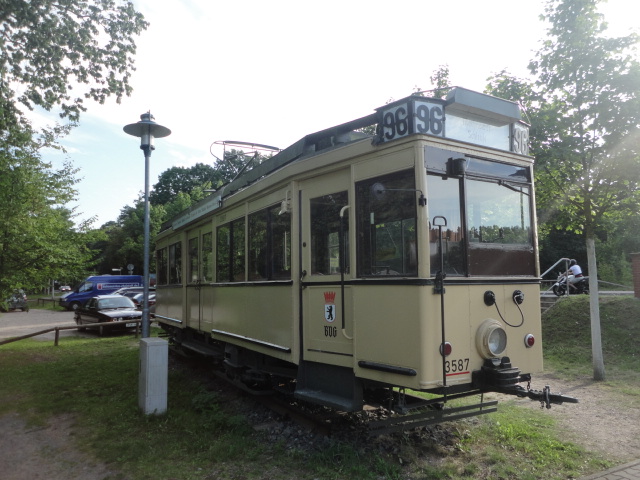
I did not know too much about Klein Machnow until a couple of months ago when someone outlined the real estate potential of this place, as many local VIPs, of various calibers, do have villas here. The decision to spend a whole summer day here was more the result of my curiosity than determined by some economic purposes. Plus, I assumed that I know quite a bunch about Berlin and its neighborhoods. What happened that I missed this apparently famous place?

I arrived there with a local bus from Berlin. Then, I took the Karl Marx Street for around 20 minutes, not before a long stop at the local weekly vegetables market. Triangle-roofed houses hidden by the high vegetation were the first noticeable observations in my first hour of exploration in Klein Machnow.

If at the first sight there were not too many traces of the former communist legacy, those little details familiar to someone that grew up in this (crazy) world were easy to spot. Maybe the attitude of some local people towards foreigners, or some buildings or just the overall impression...

Many buildings were renovated in the last years and sold to successful entrepreneurs from Berlin. The situation of real estate in Klein Machnow was subject not only to economic considerations. During the Cold War, this locality was part of the communist part. Following the reunification, around 8,000 people lived their houses that were in fact occupied illegally from owners that went in the West. It seems that history repeats itself, but this particular dispute was assigned a name: "Klein Machnow Syndrome".

A couple of streets before we were reading about what to do when meeting wild boars, a frequent presence around it seems, but now we are in the middle of the small central area and everything make you feel centuries distance from the above mentioned wilderness.

The main shops and restaurants are concentrated in the area around Sehquartier. There is nothing exquisite, just everything you need to make your life bearable before the first ride to Berlin.

The same when it comes to food. The Salumeria is the most attractive place for food and I took a seat outside, a good observation point to notice the locals between the food bites. The bruschettas are edible, not too elaborated in terms of taste - was expected more spices and maybe a bit more olive oil.

The pasta arabiatta are spicy as expected, but not too well cooked. The sauce compensates everything though, including the clumsy customer service.

With renewed forced, I continue my trip, convinced that there must be many hidden histories in these places. The street art is colourful, a testimony that there must be young people with ideas around.

The architects seem to try their hand here too, as the Bio Company shop is hosted in one of the most interesting buildings dedicated to this business, the repeated wood detail and the transparent entry being a good illustration of the messages of this company.

The only school in the locality bears the name of the Russian (Soviet) writer Maxim Gorki, a memory from the old communist times maintained in Germany without the similar shame from other communist countries - as the Karl Marx street that lead me to the city.

After a little bit of bus riding and more hiking, I arrive at one of the trademarks of this neighborhoods of Berlin. The Teltow Kanal, inaugurated in 1906, that played an important role in developing the trade network between Berlin and different locations in Germany or Poland.

Nowadays, here you can follow some short historical tours. The entire place is too peaceful to make you dream about the busy trade that used to be here just couple of decades ago.

Nearby, the old tram tells a different story. Now part of history, the 96 tram was took out of service following the establishment of the new borders of Berlin. As nothing went further the Checkpoint Bravo, this tram witnesses the isolation and alienation between the two parts of Berlin. The interior is decorated with black and white pictures from the old times and the custodian of the place is kind enough to answer my many questions around the topic: And how was is then?

As it happens often, intuitively my steps are taken to places with interesting histories. I am walking through the yards of the Hakeburg castle, a construction built in 1600, supposedly turned soon into a posh real estate destination. Old stained glass and statues covered by the rain, winds and snow, large interior yards and high walls. Used first as a castle, during the war as a private residence of the Reichpostminister, Wilhelm Ohnesorge. Destroyed by the bombings, it was opened again only in 1950, first as a school for party leaders, but also used as a private residence for various guests of the communist leadership. 

Such a small place, so many histories, many of them not yet revealed to me. As my long years of travel taught me, there is no single new place on Earth were you cannot learn something. You just need keep following your journey.
For more insights about what to do and see in Klein Machnow, check the dedicated Pinterest board
No comments:
Post a Comment